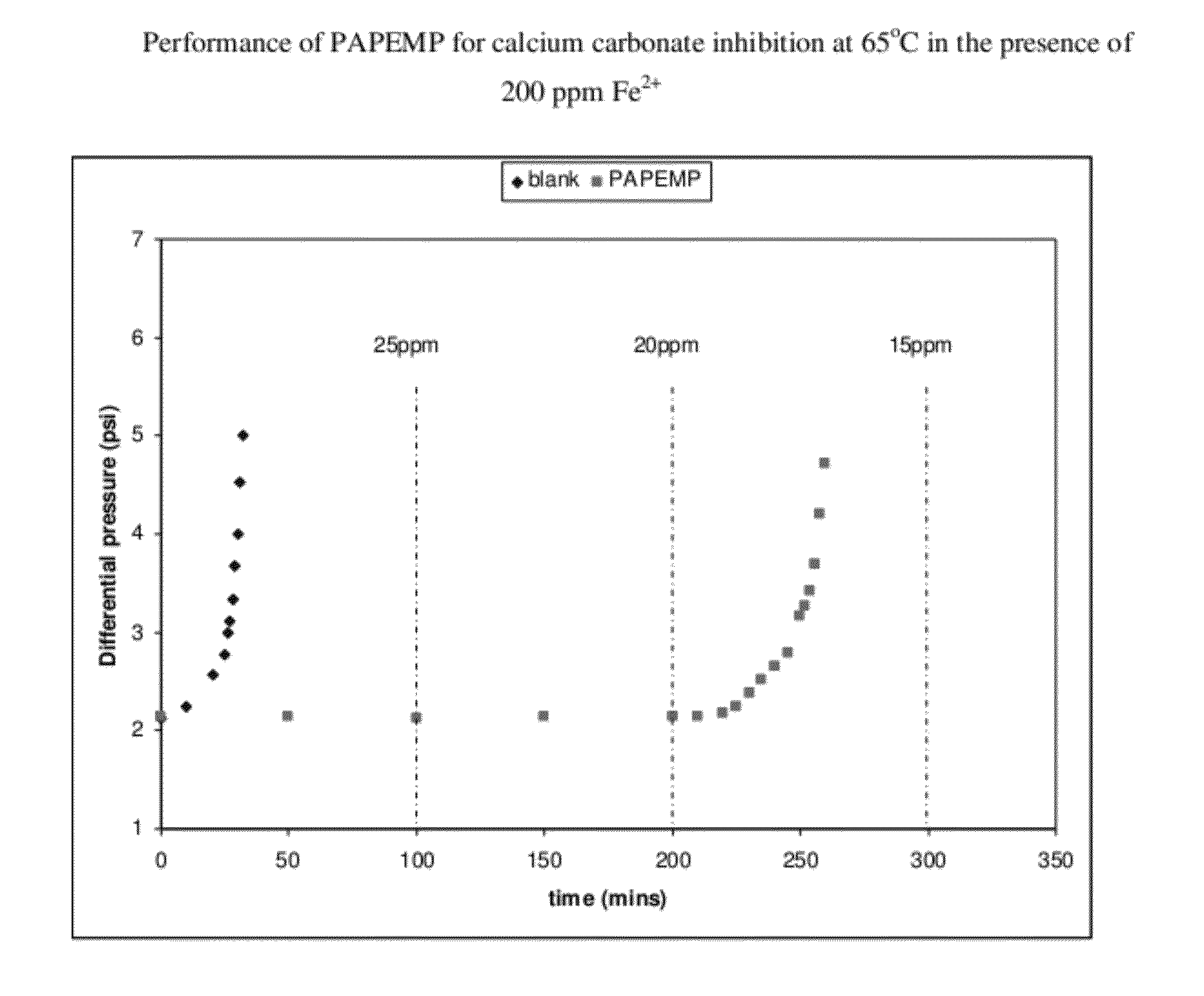Method for preventing scale formation in the presence of dissolved iron
a technology of dissolved iron and scales, which is applied in the direction of sealing/packing, quarries waste water treatment, borehole/well accessories, etc., can solve the problems of scale formation, significant reduction of well productivity, and production rate declin
- Summary
- Abstract
- Description
- Claims
- Application Information
AI Technical Summary
Problems solved by technology
Method used
Image
Examples
example 1
[0027]A static bottle test was conducted to show the scale inhibition properties of PAPEMP for calcium carbonate scale inhibition in the presence of dissolved iron. In this test, two incompatible waters with the tendency to form a scale were combined in a glass bottle, heated and then observed for scale precipitation.
[0028]A synthetic brine was made from an anionic water (AW) component and a cationic water (CW) component. Each of the AW and CW brines contained twice the concentration of the anionic and cationic salt, respectively, as well as the original concentration of sodium chloride. When the AW and CW brines were mixed at a 1:1 ratio, they produced a brine with the total dissolved solids (TDS) shown in Table 1.
[0029]
TABLE 1Synthetic high TDS waterIonConcentration (ppm)Sodium63863Calcium16200Magnesium1200Potassium314Barium0Strontium500Iron0 to 200Chloride130607Bicarbonate 1050**bicarbonate concentration was increased to 1200 ppm for the dynamic tube blocking test
[0030]The AW an...
example 2
[0032]A dynamic tube blocking test (TBT) was used to evaluate the efficiency of PAPEMP to prevent the formation and deposition of mineral scales. The TBT test aids in the determination of the minimum inhibitor concentration (MIC) required to prevent the formation of scale, and allows for the evaluation of the comparative testing of different inhibitors under similar conditions. Inhibitor efficiency is measured by the ratio of the time needed to block the tube in the presence of inhibitor divided by the time needed to block the tube in the absence of inhibitor, i.e. blank time. Conditions for the blank test are adjusted to induce significant precipitation in a reasonable time frame. The main adjusting parameters are the solution's degree of saturation of scaling species and the flow rate.
[0033]Dynamic tests complement the static tests by allowing for different facets of scale inhibitor activity to be examined. The dynamic tests examine activity under much shorter residence times than...
PUM
| Property | Measurement | Unit |
|---|---|---|
| temperature | aaaaa | aaaaa |
| length | aaaaa | aaaaa |
| internal diameter | aaaaa | aaaaa |
Abstract
Description
Claims
Application Information
 Login to View More
Login to View More - R&D
- Intellectual Property
- Life Sciences
- Materials
- Tech Scout
- Unparalleled Data Quality
- Higher Quality Content
- 60% Fewer Hallucinations
Browse by: Latest US Patents, China's latest patents, Technical Efficacy Thesaurus, Application Domain, Technology Topic, Popular Technical Reports.
© 2025 PatSnap. All rights reserved.Legal|Privacy policy|Modern Slavery Act Transparency Statement|Sitemap|About US| Contact US: help@patsnap.com



